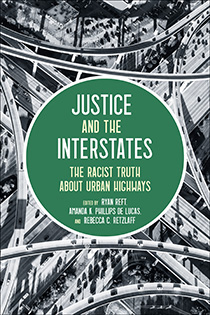When the U.S. interstate system was constructed, spurred by the Federal Aid Highway Act of 1956, many highways were purposefully routed through Black, Brown, and poor communities. These neighborhoods were destroyed, isolated from the rest of the city, or left to deteriorate over time.
Edited by Ryan Reft, Amanda Phillips de Lucas, and Rebecca Retzlaff, Justice and the Interstates examines the toll that the construction of the U.S. Interstate Highway System has taken on vulnerable communities over the past seven decades, details efforts to restore these often- segregated communities, and makes recommendations for moving forward. It opens up new areas for historical inquiry, while also calling on engineers, urban planners, transportation professionals, and policymakers to account for the legacies of their practices.
The chapters, written by diverse experts and thought leaders, look at different topics related to justice and the highway system, including:
- A history of how White supremacists used interstate highway routing in Alabama to disrupt the civil rights movement
- The impact of the highway in the Bronzeville area of Milwaukee
- How the East Los Angeles Interchange disrupted Eastside communities and displaced countless Latino households
- Efforts to restore the Rondo neighborhood of St. Paul
Justice and the Interstates provides a concise but in-depth examination of the damages wrought by highway construction on the nation’s communities of color. Community advocates, transportation planners, engineers, historians, and policymakers will find a way forward to both address this history and reconcile it with current practices.

